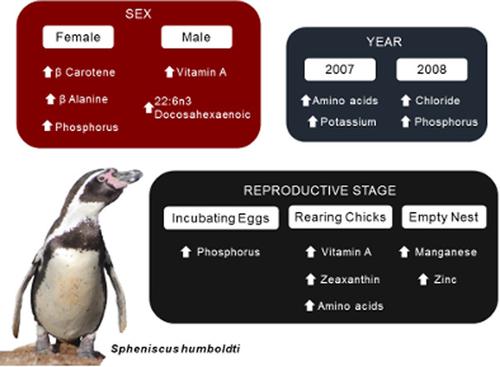Our official English website, www.x-mol.net, welcomes your
feedback! (Note: you will need to create a separate account there.)
Circulating nutrient concentrations in free-ranging Humboldt penguins (Spheniscus humboldti ) in Punta San Juan, Peru
Zoo Biology ( IF 1.2 ) Pub Date : 2020-03-29 , DOI: 10.1002/zoo.21540 Paulo Colchao 1, 2 , Michael J Adkesson 3 , Matthew C Allender 4 , Andrea J Fascetti 5 , Marco Cardeña 2 , Susana Cárdenas-Alayza 2, 3 , Ellen S Dierenfeld 6 , Sharon L Deem 1
Zoo Biology ( IF 1.2 ) Pub Date : 2020-03-29 , DOI: 10.1002/zoo.21540 Paulo Colchao 1, 2 , Michael J Adkesson 3 , Matthew C Allender 4 , Andrea J Fascetti 5 , Marco Cardeña 2 , Susana Cárdenas-Alayza 2, 3 , Ellen S Dierenfeld 6 , Sharon L Deem 1
Affiliation

|
Free-ranging Humboldt penguin (HP, Spheniscus humboldti) populations are under pressure from resource competition with industrial fisheries, habitat loss, and El Niño Southern Oscillation events. Foraging patterns for this top marine predator change during periods of aberrant oceanographic conditions and scarce fish stock numbers. These radical dietary fluctuations can lead to poor fertility, early embryonic death, poor hatchability, suppressed immune function, high chick mortality, and illness. To understand the variability of nutrient status in reproductive seasons, we measured select circulating nutrient concentrations (fat-soluble vitamins A, D, E, and carotenoids, fatty acids, amino acids, minerals, and electrolytes) of 105 HP at Punta San Juan, Peru during the first reproductive seasons of 2007 and 2008. We determined significant differences in nutrient status between sexes, years of sampling, and reproductive stages. Males (4.5 ± 0.38 kg) weighed more than females (4.0 ± 0.29 kg) and exhibited higher concentrations of vitamin A (0.71 ± 0.11 vs. 0.61 ± 0.12 µg/ml) and docosahexaenoic acid (6.70 ± 1.61 vs. 5.65 ± 1.59%). Males also displayed lower concentrations of β-carotene (0.01 ± 0.01 vs. 0.012 ± 0.001 µg/ml) and phosphorus (3.43 ± 0.83 vs. 4.40 ± 1.66 mg/dl). Comparison between the 2 years showed most circulating amino acid concentrations were higher in 2007. Significant differences in circulating amino acids and vitamins were also noted between different reproductive stages. These results demonstrate concentrations of nutrients can vary due to the physiological state of the animal, as well as the overall dynamics of their marine ecosystem habitat.
中文翻译:

秘鲁蓬塔圣胡安自由放养洪堡企鹅 (Spheniscus humboldti) 的循环营养浓度
自由放养的洪堡企鹅(HP,Spheniscus humboldti)种群面临着工业渔业资源竞争、栖息地丧失和厄尔尼诺南方涛动事件的压力。在海洋条件异常和鱼类数量稀少期间,这种顶级海洋捕食者的觅食模式会发生变化。这些剧烈的日粮波动会导致繁殖力差、胚胎过早死亡、孵化率差、免疫功能受到抑制、雏鸡死亡率高和疾病。为了了解生殖季节营养状况的变化,我们在 Punta San Juan 测量了 105 HP 的特定循环营养浓度(脂溶性维生素 A、D、E 和类胡萝卜素、脂肪酸、氨基酸、矿物质和电解质),秘鲁在 2007 年和 2008 年的第一个繁殖季节。我们确定了性别、采样年份和生殖阶段之间营养状况的显着差异。雄性 (4.5 ± 0.38 kg) 比雌性 (4.0 ± 0.29 kg) 重,并且表现出更高浓度的维生素 A(0.71 ± 0.11 与 0.61 ± 0.12 µg/ml)和二十二碳六烯酸(6.70 ± 1.61 与 5.695% ± 1) )。男性还显示出较低浓度的 β-胡萝卜素(0.01 ± 0.01 与 0.012 ± 0.001 µg/ml)和磷(3.43 ± 0.83 与 4.40 ± 1.66 mg/dl)。两年之间的比较表明,2007 年大多数循环氨基酸浓度较高。在不同生殖阶段之间,循环氨基酸和维生素也存在显着差异。这些结果表明,营养物质的浓度会因动物的生理状态而有所不同,
更新日期:2020-03-29
中文翻译:

秘鲁蓬塔圣胡安自由放养洪堡企鹅 (Spheniscus humboldti) 的循环营养浓度
自由放养的洪堡企鹅(HP,Spheniscus humboldti)种群面临着工业渔业资源竞争、栖息地丧失和厄尔尼诺南方涛动事件的压力。在海洋条件异常和鱼类数量稀少期间,这种顶级海洋捕食者的觅食模式会发生变化。这些剧烈的日粮波动会导致繁殖力差、胚胎过早死亡、孵化率差、免疫功能受到抑制、雏鸡死亡率高和疾病。为了了解生殖季节营养状况的变化,我们在 Punta San Juan 测量了 105 HP 的特定循环营养浓度(脂溶性维生素 A、D、E 和类胡萝卜素、脂肪酸、氨基酸、矿物质和电解质),秘鲁在 2007 年和 2008 年的第一个繁殖季节。我们确定了性别、采样年份和生殖阶段之间营养状况的显着差异。雄性 (4.5 ± 0.38 kg) 比雌性 (4.0 ± 0.29 kg) 重,并且表现出更高浓度的维生素 A(0.71 ± 0.11 与 0.61 ± 0.12 µg/ml)和二十二碳六烯酸(6.70 ± 1.61 与 5.695% ± 1) )。男性还显示出较低浓度的 β-胡萝卜素(0.01 ± 0.01 与 0.012 ± 0.001 µg/ml)和磷(3.43 ± 0.83 与 4.40 ± 1.66 mg/dl)。两年之间的比较表明,2007 年大多数循环氨基酸浓度较高。在不同生殖阶段之间,循环氨基酸和维生素也存在显着差异。这些结果表明,营养物质的浓度会因动物的生理状态而有所不同,











































 京公网安备 11010802027423号
京公网安备 11010802027423号